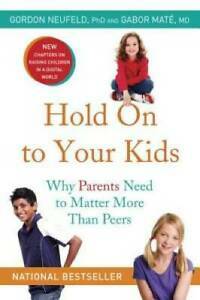You need to sign in or sign up before continuing.
Take a photo of a barcode or cover
196 reviews for:
Hold On to Your Kids: Why Parents Need to Matter More Than Peers
Gabor Maté, Gordon Neufeld
196 reviews for:
Hold On to Your Kids: Why Parents Need to Matter More Than Peers
Gabor Maté, Gordon Neufeld
informative
slow-paced
A little repetitive, but some helpful ideas, particularly on the diagnosis side.
If pseudo-science, adultism, baby boomers shirking responsibility for their actions, and the nostalgic recall of pre-WWII American societal norms are your thang, you might appreciate this book. If not, maybe don’t bother.
notes for homeschoolers: http://flowingwithmyducklings.blogspot.com/2011/11/learning-from-gordon-neufeld-part-i.html
informative
medium-paced
Takeaways from reading the book:
What characterizes children?
- Pages 92-93: Children constantly search for how to be and what to do. The child's brain will automatically scan for cues from whomever the child is primarily attached to. If a child's attachment brain is oriented to the parent, these cues will come from the parent's face, reactions, values, communications and gestures.
- Page 107: Counterwill is serving the purpose of protecting the child against becoming an extension of anyone else, even the parent. It helps to deliver an autonomous, emergent, independent being, full of vitality and able to function outside of attachments.
Why is attachment between children and parents important?
- Page 69: The authority to parent flows from an appropriately aligned relationship with / attachment to the child.
- Page 71: A child is born completely dependent. It is the child's state of dependence that makes parenting necessary in the first place.
- Page 75: It takes 3 ingredients to make parenting work: 1. A dependent child who has a need for being taken care of. 2. An adult who is willing to take responsibility for parenting. 3. A good working attachment from / relationship between the child to the adult. The most critical of these 3 ingredients is the child's attachment to the adult.
- Pages 83-85: Attachment arranges the parent and child hierarchically. With adults, a child is meant to be in a dependent, care-seeking mode and have parents who take charge and assume responsibility for the child.
- Page 88: No person can truly command the attention of another. Attention follows attachment.
- Page 111: When child-adult attachments are not strong enough, focus on rewards and punishments such as the forbidding of computer time, separation from friends, and limitation of television time increases.
- Page 130: Attachment to parents renders a child vulnerable in relationship to them but less vulnerable in relation to others. The more attached a child is to parents, the more capable he or she is of being wounded.
- Page 140: The more children are attached to caring adults, the more they are able to interact with peers without being overwhelmed by the vulnerability involved.
What are ways that parents can create attachment with their children?
# 1: Physical attachment and attachment through senses.
Pages 20 and 37: At the beginning of life, the attachment that a child has to his or her parents is physical. The child uses his or her senses to create attachment to his or her parents. The child smells, observes, listens and touches.
# 2: Attachment by imitating the parent, being the same as the parent, identifying with the parent and being one with the parent.
Page 38: The more attached a child is to his or her parent / parents, the more the child wants to be the same as his or her parent / parents, for example regarding humor and/or food preferences.
# 3: Attachment through belonging and loyalty.
Page 38: This kind of attachment relates to being faithful and obedient to one's chosen attachment figures.
# 4: Attachment by pleasing.
Page 39: Children, who live for the happy face of those they are attached to, are sensitive to looks of displeasure and disapproval. This kind of attachment makes the child vulnerable to being hurt.
# 5: Pages 20 and 40: Attachment through warm and loving feelings.
# 6: Attachment by sharing secrets, concerns and insecurities about themselves.
Page 40: There is no closeness that can surpass the sense of feeling known and still being liked, accepted and welcomed.
What characterizes relationships that children have with other children?
- Page 21-23: For the first time in history, young people choose to be brought up more by other children, i.e. their peers, than by their parents.
- Page 24: Culture - including celebrations, stories, and music - used to be passed on from parents to children. Now, children are creating their own culture with other children. And this culture is distinct from that of their parents.
- Page 25: What is missing in peer relationships is unconditional love and acceptance.
- Page 120: Peer culture is momentary and created daily. It lacks traditions and history.
- Page 133: When peers replace parents, children lose their vital protection against the thoughtlessness of others.
- Page 136: Peer-oriented children are obsessed with who likes whom, who prefers whom and who wants to be with whom.
Other research from the book:
- Page 96: Do not make a child feel bad, guilty or ashamed in order to get him or her to be good.
- Page 135: Carl Jung explained that we tend to attack in others what we are most uncomfortable with in ourselves.
To be updated.
What characterizes children?
- Pages 92-93: Children constantly search for how to be and what to do. The child's brain will automatically scan for cues from whomever the child is primarily attached to. If a child's attachment brain is oriented to the parent, these cues will come from the parent's face, reactions, values, communications and gestures.
- Page 107: Counterwill is serving the purpose of protecting the child against becoming an extension of anyone else, even the parent. It helps to deliver an autonomous, emergent, independent being, full of vitality and able to function outside of attachments.
Why is attachment between children and parents important?
- Page 69: The authority to parent flows from an appropriately aligned relationship with / attachment to the child.
- Page 71: A child is born completely dependent. It is the child's state of dependence that makes parenting necessary in the first place.
- Page 75: It takes 3 ingredients to make parenting work: 1. A dependent child who has a need for being taken care of. 2. An adult who is willing to take responsibility for parenting. 3. A good working attachment from / relationship between the child to the adult. The most critical of these 3 ingredients is the child's attachment to the adult.
- Pages 83-85: Attachment arranges the parent and child hierarchically. With adults, a child is meant to be in a dependent, care-seeking mode and have parents who take charge and assume responsibility for the child.
- Page 88: No person can truly command the attention of another. Attention follows attachment.
- Page 111: When child-adult attachments are not strong enough, focus on rewards and punishments such as the forbidding of computer time, separation from friends, and limitation of television time increases.
- Page 130: Attachment to parents renders a child vulnerable in relationship to them but less vulnerable in relation to others. The more attached a child is to parents, the more capable he or she is of being wounded.
- Page 140: The more children are attached to caring adults, the more they are able to interact with peers without being overwhelmed by the vulnerability involved.
What are ways that parents can create attachment with their children?
# 1: Physical attachment and attachment through senses.
Pages 20 and 37: At the beginning of life, the attachment that a child has to his or her parents is physical. The child uses his or her senses to create attachment to his or her parents. The child smells, observes, listens and touches.
# 2: Attachment by imitating the parent, being the same as the parent, identifying with the parent and being one with the parent.
Page 38: The more attached a child is to his or her parent / parents, the more the child wants to be the same as his or her parent / parents, for example regarding humor and/or food preferences.
# 3: Attachment through belonging and loyalty.
Page 38: This kind of attachment relates to being faithful and obedient to one's chosen attachment figures.
# 4: Attachment by pleasing.
Page 39: Children, who live for the happy face of those they are attached to, are sensitive to looks of displeasure and disapproval. This kind of attachment makes the child vulnerable to being hurt.
# 5: Pages 20 and 40: Attachment through warm and loving feelings.
# 6: Attachment by sharing secrets, concerns and insecurities about themselves.
Page 40: There is no closeness that can surpass the sense of feeling known and still being liked, accepted and welcomed.
What characterizes relationships that children have with other children?
- Page 21-23: For the first time in history, young people choose to be brought up more by other children, i.e. their peers, than by their parents.
- Page 24: Culture - including celebrations, stories, and music - used to be passed on from parents to children. Now, children are creating their own culture with other children. And this culture is distinct from that of their parents.
- Page 25: What is missing in peer relationships is unconditional love and acceptance.
- Page 120: Peer culture is momentary and created daily. It lacks traditions and history.
- Page 133: When peers replace parents, children lose their vital protection against the thoughtlessness of others.
- Page 136: Peer-oriented children are obsessed with who likes whom, who prefers whom and who wants to be with whom.
Other research from the book:
- Page 96: Do not make a child feel bad, guilty or ashamed in order to get him or her to be good.
- Page 135: Carl Jung explained that we tend to attack in others what we are most uncomfortable with in ourselves.
To be updated.
informative
reflective
medium-paced
I listened to the audio book, which was released in 2018, but it has definitely been updated as there is mention of the pandemic and outcomes for children.
This is a dense and comprehensive read.
This is a dense and comprehensive read.
informative
reflective
slow-paced
Some good info here, but also got a bit repetitive, which made it drag a bit. Good read overall.
I have all kinds of feelings about this book. It has really great suggestions for how parents can strengthen their attachment bonds with their kids, and rightly locates psychological and behavioral problems in broken attachment relationships instead of in kids themselves. But the whole thing relies on moral panic, using a Golden Age argument to denigrate popular culture and digital technologies. It all felt really true and also deeply conservative, wanting to “go back” to a better time when kids were more connected to their parents. I can’t recommend it, but I can see (i.e., I experienced) its appeal.




